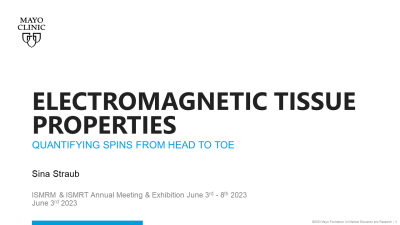Weekend Course
Quantifying Spins from Head to Toe
ISMRM & ISMRT Annual Meeting & Exhibition • 03-08 June 2023 • Toronto, ON, Canada

| 08:00 |
Clinical Needs & Challenges for Neuro & Body Imaging
Won-Jin Moon
Keywords: Image acquisition: Quantification, Image acquisition: Sequences, Image acquisition: Multiparametric This lecture highlights the clinical needs and challenges of neuro and body MRI, with a focus on Alzheimer's, Parkinson's, epilepsy, cancer, and liver disease. Although MR imaging is a powerful tool, standard techniques may not provide the necessary information for accurate diagnosis and treatment monitoring. Advanced MRI and quantitative approaches offer promising results but have yet to fully penetrate clinical practice due to their limitations. The lecture emphasizes the need for interdisciplinary collaboration to advance the field and meet clinical demands. The potential of emerging technologies such as AI-driven image reconstruction and quantitative MRI is discussed as future directions. |
|
| 08:30 |
 |
Diffusion
Daniel Ennis
Keywords: Contrast mechanisms: Diffusion Diffusion weighted MRI (DWI) and diffusion-tensor MRI (DTI) are MRI techniques that enable measuring the self-diffusion of water molecules in soft tissues. DWI and DTI methods enable quantitative estimates of the apparent diffusion coefficient (ADC) or mean diffusivity (MD), fractional anisotropy (FA), fastest direction of diffusion (eigenvectors and tracts), and more. DWI and DTI measures are uniquely sensitive to tissue orientation and organization and provide insight to tissue changes that accord with edema, anisotropy, cellularity, and more. DWI and DTI are powerful research and diagnostic clinical tools with applications in the brain, body (abdominal), chest, muscles, prostate, breasts, and beyond. |
| 09:00 |
Metabolites by MRS/MRSI
Esin Ozturk-Isik
Keywords: Contrast mechanisms: Spectroscopy Magnetic resonance spectroscopic imaging (MRS/I) provides metabolic markers that could be employed for improved patient management. This talk will summarize the challenges of MRS/I, recent advances for a more standardized approach, machine learning studies for improved MRS/I, and the importance of quantitative metabolic markers of the brain and other body parts in the clinics. |
|
| 09:30 |
Break & Meet the Teachers |
|
| 10:00 |
 |
Electromagnetic Tissue Properties
Sina Straub
Keywords: Contrast mechanisms: Electromagnetic tissue properties It will be explained on which tissue properties magnetic susceptibility, electric permittivity and electric conductivity depend, what data needs to be acquired to map these properties, influence these properties depend on field strength. Learn that:
|
| 10:30 |
Mechanical Tissue Properties
Meng Yin
Keywords: Contrast mechanisms: Elastography Many disease processes cause marked changes in tissue mechanical properties. Mechanical properties are therefore promising biomarkers for monitoring and characterizing various pathophysiologic conditions of soft tissues. MR-based elastography is a phase-contrast technique for estimating multiple mechanical properties and boundary conditions by imaging propagating shear waves generated from a standardized extrinsic vibrating source. In practice, the innovative stiffness biomarker is beginning to see widespread clinical use for assessing hepatic fibrosis as an alternative to biopsy. There is significant potential to further develop elastography techniques to implement three-dimensional multiparametric methods that have promise for distinguishing varying pathophysiologic states of many other organs. |
|
| 11:00 |
Promoting Standardization and Dissemination of Quantitative MRI
Technology
Richard Ehman
Keywords: Image acquisition: Quantification, Transferable skills: Commercialisation, Transferable skills: Intellectual Property This presentation focuses on strategies for promoting standardization and dissemination of quantitative MRI technology, spanning the pathway from invention to eventual adoption in patient care. The presentation draws on lessons that were learned in the development and dissemination of MR elastography, which is now a standard of clinical practice, deployed on thousands of MRI systems around the world. This presentation reviews strategies for addressing hurdles and opportunities, technical and regulatory challenges, and approaches for obtaining clinical buy-in for new quantitative MRI-based techniques. |
The International Society for Magnetic Resonance in Medicine is accredited by the Accreditation Council for Continuing Medical Education to provide continuing medical education for physicians.